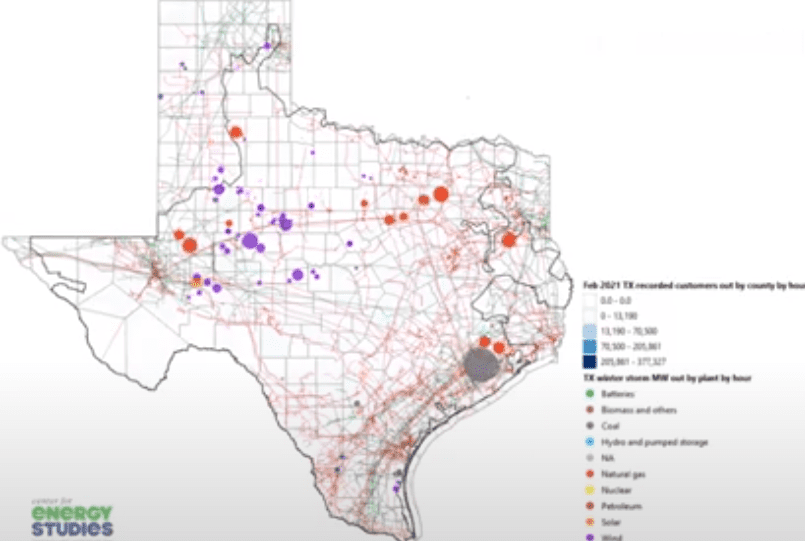HOUSTON – What happened to electrical power in Texas during last February’s freeze? A new time-lapse video of electricity generation created by experts at Rice University’s Baker Institute for Public Policy offers an hour-by-hour picture of power plant and customer outages across the state during the devastating storm.
The freeze crippled the Texas power grid, which is managed by the Electric Reliability Council of Texas (ERCOT). The 30-second video shows ERCOT’s daily generation of fuel between Feb. 10 and Feb. 28 by resource type: natural gas, coal, solar, wind and more. These resources are juxtaposed with visualizations of power plant and customer outages during the freeze.
Created by Kenneth Medlock, senior director of the Baker Institute’s Center for Energy Studies, and Elsie Hung, research manager at the center, the time-lapse video shows that all types of power-generating resources experienced outages or reductions under the strain of the extreme cold. At the peak of the freeze on Feb. 16, over 30% of ERCOT’s winter capacity was offline, forcing it to issue load-shed orders — rolling blackouts, which left millions cold and in the dark for days.
Hung and Medlock also created two other time-lapse videos: one to illustrate daily electric generation by resource in ERCOT since Jan. 1, 2009, and another that includes day-ahead load, or projected demand in megawatts, since June 5, 2011. These videos were produced to provide insight into the development of the Texas power grid’s fuel mix.
The video of daily generation by resource runs about 25 minutes, and it will be updated quarterly. Users can pinpoint a specific date or utilize time stamps below the video to reference major events.
The video that highlights the evolution of the Texas fuel mix runs 2 1/2 minutes.
To schedule an interview with Hung or Medlock, or for more information, contact Avery Franklin, media relations specialist at Rice, at averyrf@rice.edu or 713-348-6327.
Related materials:
Videos: https://www.bakerinstitute.org/electricity-in-texas/.
Follow the Baker Energy Studies via Twitter @CES_Baker_Inst.
Follow Rice News and Media Relations via Twitter @RiceUNews.
This news release can be found online at news.rice.edu.
Founded in 1993, Rice University’s Baker Institute ranks as the No. 2 university-affiliated think tank in the world and the No. 1 energy think tank in the world. As a premier nonpartisan think tank, the institute conducts research on domestic and foreign policy issues with the goal of bridging the gap between the theory and practice of public policy. The institute’s strong track record of achievement reflects the work of its endowed fellows, Rice University faculty scholars and staff, coupled with its outreach to the Rice student body through fellow-taught classes — including a public policy course — and student leadership and internship programs. Learn more about the institute at www.bakerinstitute.org or on the institute’s blog, http://blog.bakerinstitute.org.
Located on a 300-acre forested campus in Houston, Rice University is consistently ranked among the nation’s top 20 universities by U.S. News & World Report. Rice has highly respected schools of Architecture, Business, Continuing Studies, Engineering, Humanities, Music, Natural Sciences and Social Sciences and is home to the Baker Institute for Public Policy. With 4,052 undergraduates and 3,484 graduate students, Rice’s undergraduate student-to-faculty ratio is just under 6-to-1. Its residential college system builds close-knit communities and lifelong friendships, just one reason why Rice is ranked No. 1 for lots of race/class interaction and No. 1 for quality of life by the Princeton Review. Rice is also rated as a best value among private universities by Kiplinger’s Personal Finance.






